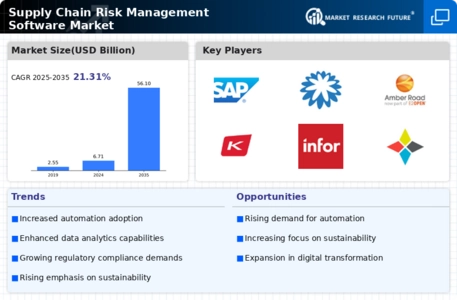Sustainability Considerations
Sustainability has emerged as a crucial driver within the Supply Chain Risk Management Software Market, as organizations increasingly prioritize environmentally responsible practices. Companies are now seeking software solutions that not only manage risks but also promote sustainable supply chain operations. This includes tracking carbon footprints, optimizing resource usage, and ensuring ethical sourcing. Research indicates that businesses with robust sustainability practices can achieve up to a 30% increase in operational efficiency. As stakeholders demand greater accountability regarding environmental impact, the integration of sustainability features in risk management software becomes essential, thereby propelling growth in the Supply Chain Risk Management Software Market.
Focus on Regulatory Compliance
In an increasingly complex regulatory landscape, the Supply Chain Risk Management Software Market is driven by the necessity for compliance with various international standards and regulations. Organizations are compelled to adopt software solutions that facilitate adherence to these regulations, which can vary significantly across regions. The demand for compliance-related features in risk management software is projected to grow, as companies seek to avoid penalties and reputational damage. For example, the implementation of software that ensures compliance with the ISO 28000 standard can enhance security and efficiency in supply chains. This focus on regulatory compliance is thus a critical factor influencing the Supply Chain Risk Management Software Market.
Rising Complexity of Supply Chains
The growing complexity of supply chains, characterized by globalization and multi-tiered networks, is a significant driver for the Supply Chain Risk Management Software Market. As companies expand their operations across borders, they encounter a myriad of risks, including geopolitical tensions, natural disasters, and supplier reliability issues. This complexity necessitates sophisticated software solutions that can provide real-time visibility and risk assessment across the entire supply chain. The market for such solutions is expected to expand, with estimates suggesting a compound annual growth rate of 12% over the next five years. Consequently, the demand for effective risk management software is likely to surge, underscoring its importance in the Supply Chain Risk Management Software Market.
Integration of Advanced Technologies
The Supply Chain Risk Management Software Market is experiencing a notable shift towards the integration of advanced technologies such as artificial intelligence, machine learning, and blockchain. These technologies enhance predictive analytics, enabling organizations to identify potential risks before they escalate. For instance, AI algorithms can analyze vast datasets to forecast disruptions, while blockchain ensures transparency and traceability in supply chains. According to recent estimates, the adoption of AI in supply chain management could lead to a 20% reduction in operational costs. This technological evolution not only streamlines processes but also fosters resilience against unforeseen challenges, making it a pivotal driver in the Supply Chain Risk Management Software Market.
Increased Focus on Supply Chain Resilience
In the current business environment, there is an increased emphasis on building supply chain resilience, which serves as a key driver for the Supply Chain Risk Management Software Market. Organizations are recognizing the need to not only identify risks but also to develop strategies to mitigate them effectively. This shift towards resilience involves investing in software that can simulate various risk scenarios and provide actionable insights. The market is witnessing a trend where companies are allocating more resources to enhance their risk management capabilities, with projections indicating a potential increase in spending by 15% in the coming years. This focus on resilience is thus shaping the landscape of the Supply Chain Risk Management Software Market.


















Leave a Comment